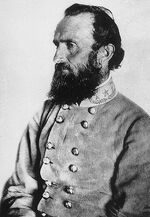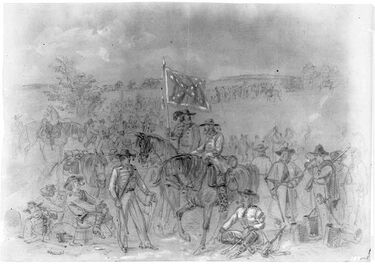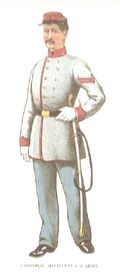
Seal of the Confederate States of America
The Uniforms of the Confederate States military forces were the uniforms used by the Confederate Army and Navy during the American Civil War, from 1861 to 1865. The uniform varied greatly due to a variety of reasons, such as location, limitations on the supply of cloth and other materials, and the cost of materials during the war.
Confederate forces were often poorly supplied with uniforms, especially late in the conflict. Servicemen sometimes wore combinations of uniform pieces, also wearing captured Union uniforms, and items of personal clothing. They sometimes went without shoes altogether, and broad felt or straw hats were worn as often as kepis or naval caps. There are some controversies about some of the exact details of a few of the uniforms, since some of the records were lost or destroyed after the Civil War ended.
Overview[]
The original Confederate uniforms from all branches of the military closely followed the lines of the Union’s uniforms. Near the beginning of the war, some Confederate units wore dark blue outfits that were often mistaken at the field of battle for the enemy, conversely, many Union units which were originally militia units went to war wearing grey. By 1863, all troops were asked to obey the Regulations for the Army of the Confederacy and have cadet grey uniforms. The Confederates' frock coat that was to be hung to mid thigh, was given to the officers and enlisted men of the infantry. The coats were also double breasted. Buttons, insignias, and chevrons were not as richly decorated as those used by the Union Army. They were also more diverse in shape, especially in the Deep South and out West. While hats had to match the specified color, the lack of materials meant soldiers often wore what hats they could find, and the continued need for fabric after the war means that relatively few Confederates hats have survived.[1]
Cavalrymen, artillerists, and infantry followed the same designations and insignia, but cavalrymen and artillerists wore waist-length jackets. The ankle-high "Jefferson Boot" was supposed to be supplied to all officers and men of the army. Overcoats were also cadet grey and followed the lines of the design of the Union overcoats. Confederate naval uniforms had few differences from those of the Union. The prescribed color of grey was the predominant color. During the summer months, white was accepted for tropical wear. At the end of the war even grey dyes were hard to come by. This forced even officers to wear "butternut" colored uniforms.[2]
| Uniforms of the Confederate Military | ||||||||||
|---|---|---|---|---|---|---|---|---|---|---|
| CSA Army | CSA Navy | CSA Cavalry | CSA Artillery | |||||||
Design[]

Confederate Battle Flag
The use of wool in the uniform meant that the uniforms were not suited to the warm climates that were common in the South. This helped contribute to the fact that many Confederate soldiers suffered from heatstroke on long marches.[3]
The grey was not the best choice as a camouflage, although at the time the usefulness of camouflage was not generally recognized. It was not until the Spanish-American War that the United States Army instituted a khaki uniform. Grey was chosen for Confederate uniforms because grey dye could be made relatively cheaply.[4]
Confederate States Army uniforms[]
Army officers[]
Generals[]

Example of the Three Gold Stars and Wreath on a General's Collar
On the upright collar of full generals, lieutenant generals, major generals, and brigadier generals three stars were stitched within a wreath, all embroidered in gold coloring. The center star was slightly larger than the other stars.[5] It was not possible to know which grade of general an officer was by their collar insignia. However, major generals and lieutenant generals wore three groups of buttons down the front of the overcoat, and brigadiers wore groups of two.[5]
Other officers[]
Colonels wore three gold stars of the same size on their collar; the same as generals, but without the wreath. While lieutenant colonels wore two stars on their collars, majors wore one star, which was placed in the middle of the collar. Captains had three gold horizontal bars, first lieutenants wore two bars, and second lieutenants wore one bar.[5] However, the Confederate Congress often created new commissions, and did not always standardize rank insignia immediately.[6]
| Collar Insignias of the Confederate Army | ||||||||||
|---|---|---|---|---|---|---|---|---|---|---|
| General | Colonel | Lieutenant Colonel | Major | Captain | First Lieutenant | Second Lieutenant | ||||

|

|

|

|
|||||||
Army enlisted men[]
Chevrons[]
Chevrons in the Confederate Army were only worn by sergeants and corporals. Sergeants wore three chevrons on their sleeves, and corporals wore two chevrons.[5]
| Chevrons of the Confederate Military | |||||||||
|---|---|---|---|---|---|---|---|---|---|
| Sergeant Major | Quartermaster Sergeant | Ordnance Sergeant | First Sergeant | ||||||

|

|

|

| ||||||
| Sergeant | Corporal | Musician | Private | ||||||

|

|
no insignia | no insignia | ||||||
Buttons[]
A brigadier general's coat had two rows of eight buttons, grouped in pairs. The other junior officers wore two rows of seven equally spaced buttons each.[5]
Jackets[]
Confederate Army officers indicated their military affiliation with different colored facing on their coats or jackets. The colors were red for artillery, yellow for cavalry, light blue for infantry, and black for medical. Regimental officers wore the colors on the outer seam of their pants on one and one-quarter inch stripes. Generals wore two and five-eighths inch stripes on each pant leg. While the quartermasters, commissary, and engineer officers wore a single gold, one and one-quarter inch outer-seam stripe. Noncommissioned officers were to wear on their outer seams a one and one-quarter inch cotton stripe or braid of colors appropriate to their army branch. [7]
| Sleeve Insignias of the Confederate Military with Collar Insignias Also | ||||||||||
|---|---|---|---|---|---|---|---|---|---|---|
| General | Colonel | Lieutenant Colonel | Major | Captain | First Lieutenant | Second Lieutenant | ||||

|

|

|

|

|

|

| ||||
Kepis[]
The kepi was also standard issue to all army personnel, with dark blue crowns for generals, staff officers, and engineers. They were of different colors, red for artillery officers, yellow for cavalry officers, and light or sky blue for infantry officers. All crowns of the kepis were to be cadet grey.[5]
| Officer Kepis of the Confederate Military | ||||||||||
|---|---|---|---|---|---|---|---|---|---|---|
| General | Cavalry Colonel | Infantry Captain | Artillery Lieutenant | |||||||

|

|

|

| |||||||
Trousers[]
The Confederate trousers were very similar to those of the Union forces.[7] Early on the trousers were sky blue in color. They were most often made of wool, and were easily worn during long marches.[7] If trousers did not arrive for the troops the soldiers would have to use their own pants to wear.[7]

Example of a CS Belt Buckle

Example of a CSA Belt Buckle
Belt[]
There were numerous types of belts produced for the Confederate Military during the Civil War. There were two types of belts which were standard to all army personal. The CS, standing for Confederate States, and CSA belt, standing for Confederate States of America. The buckles themselves were made of brass and were produced in multiple plants in the South and throughout the World.[8]. Whether the belt was one with a CS or CSA on the buckle depended on the location at which it was made and on the maker. Some Confederate soldiers were issued with, or otherwise obtained, belt buckles with insignias unique to the state they came from or served under the command of. At the beginning of the war, soldiers with experience in the U.S. Army could often be seen still wearing "US" belt buckles, as this would have been all that they had available. As supplies became more difficult to obtain near the end of the war, buckles captured from Union forces were also worn.[8]
Cavalry Uniforms[]

Example of a Confederate cavalryman wearing the stag hat
Design[]
The first of the Cavalry uniforms were made by the cavalrymen themselves. By 1862, the Confederate regulations ordered the uniform to become organized, being cadet grey and lined with a thin layer around the sleeve. The pant legs were light blue with a yellow strip rising from the bottom of the leg to the top. Non-commissioned officers of the cavalry wore either regular clothes from home or a variety of different types of uniforms.[5]
Buttons[]
A normal junior officer had two rows of evenly spaced seven buttons, grouped into pairs.[5]
Hats[]
The kepi was also standard issue to all army personnel. In the cavalry the color of the kepi was to be yellow.[5] More common than the kepi was the Confederate stag hat, which was worn by most of the Confederate Cavalry.[9]
Artillery Uniforms[]
Design[]
The first of the Artillery uniforms were a variety of handmade and personally customized uniforms. By 1862, the Confederate uniforms became organized. They became cadet grey and were to be lined with a layer of red around the sleeve. The pant legs were light blue. Even after the uniforms were organized many of the artillerymen wore regular clothes due to the heat and discomfort caused by the regular uniforms.[5]
Buttons[]
In the Confederate Artillery a normal junior officer had two rows of seven evenly spaced buttons, grouped into pairs, while a senior officer could have as many as eight buttons in two rows.[5]
Hats[]
The kepi was also standard issue to the artillerymen, they were made red to match that of the rest of their uniforms. During the summer months they were also allowed to wear straw hats because of the heat.[5]
[]
Design[]

Confederate States Navy Department
The first of the Navy uniforms were made in dark blue, but with the Southern style of rank insignia for the officers. The 1862 Confederate regulations ordered the uniform to be steel grey and lined with a dark black silk serge. They were also made in medium grey and cadet grey. They were made of wool, and these uniforms were not fit for the heat of the lower decks of a ship.[10] Non-commissioned officers wore a variety of uniforms, or even regular clothing. [11]
| Insignia location |
Admiral | Captain | Commander | Lieutenant | Master | Passed Midshipman |
Midshipman |
|---|---|---|---|---|---|---|---|
| Sleeves |  |
 |
 |
 |
 |
 |
 |
| Shoulder Straps |
|||||||
| Cover |  |
 |
 |
 |
 |
 |

|
Shoulder Straps[]
Example of a Confederate Naval Officer's Uniform
According to the dress code of the Confederate Navy, shoulder straps were to be worn differently by each rank.[12]
- Admirals wore a shoulder strap of sky-blue cloth, edged with black, that was four inches long and one inch and three-eighths wide embroidered with gold one-quarter of an inch in width. They had five stars spaced equally, the two on the ends six-tenths of an inch in diameter, and the three intermediate stars six-eighths of an inch in diameter.
- Flag officers wore a shoulder strap of sky-blue cloth, edged with black, that was four inches long and one inch and three-eighths wide embroidered with gold one-quarter of an inch in width. They had four stars spaced equally, the two on the ends six-tenths of an inch in diameter, and the two intermediate stars six-eighths of an inch in diameter.
- captains wore the same shoulder straps as the flag officers, but with three equally spaced stars, each six-tenths of an inch in diameter.
- Commanders also had the same shoulder straps, but with only two stars.
- Lieutenants had the same shoulder straps, with a single, central, star.
- The shoulder straps worn by masters had the same design, but without any stars.
- Passed midshipmen wore a strip of gold lace four inches in length and a half an inch wide.
- For a midshipman, no shoulder straps were to be worn.[12]
Caps[]
Confederate Naval Caps were made of steel grey cloth.[12] They were not to be less than three inches and a half, nor more than four inches in height. They were also not to be more than ten, or less than nine inches and a half, at the top, and had a patent leather visor, to be worn by all officers in their service dress.
- For a flag officer, the cap had a anchor in an open wreath of oak leaves, with four stars above the anchor. They were to be embroidered in gold as per pattern.
- For a captain, the same as a flag officer's, except that there were only three stars above the anchor, and the gold band was one and one-half inches wide.[12]
- For a commander it was to be the same as for a captain, except that there were only but two stars.
- For a lieutenant, the same as that of a captain, except there was only one star.
- For a master, the same as for a captain, except that there was no star.
- For a passed midshipman, an anchor without a wreath.
- For a midshipman, no caps were to be worn.[12]
Confederate States Marine Corps uniforms[]
The uniform used by the Confederate States Marine Corps resembled that prescribed for the Confederate Army. However, there is controversy about some of the exact details of the uniform, since the CSMC was not as large, and many of its records were destroyed. In 1865, right after the war's end, Lloyd J. Beall, commander of the CSMC, had a fire at his home which destroyed most of the CSMC's records.[13] It is clear, however, that the Marines were often equipped out of the stores of whichever garrison was nearest their location. One description has the Marines dressed in, frock coats of a particular (and undetermined) shade of gray, and dark blue or black trousers. It appears that Confederate Marines wore forage caps although it is unclear if there was any ornamentation on the cover.[14] Much of the gear worn by the CSMC was imported from Russia, and from Great Britain and its empire, mainly Canada. This created a fairly unique look.[13]
See also[]
- Military of the Confederate States of America
- United States Civil War
- Confederate States Army
- Confederate States Navy
- Confederate States Marine Corps
- Uniform of the Union Army
Notes and References[]
Notes[]
- ↑ Miller pp.118-120
- ↑ Miller pg. 124
- ↑ Mansfield pg. 33
- ↑ Smith pg. 25
- ↑ 5.00 5.01 5.02 5.03 5.04 5.05 5.06 5.07 5.08 5.09 5.10 5.11 Davis pp. 390-1.
- ↑ Miller pg. 122
- ↑ 7.0 7.1 7.2 7.3 Troiani pp. 106-107
- ↑ 8.0 8.1 Shaw pg. 134-135
- ↑ Troiani pg. 105
- ↑ Konstam, (2001) pg. 1873
- ↑ Faust pg. 770
- ↑ 12.0 12.1 12.2 12.3 12.4 Van Doren Stern pg. 233
- ↑ 13.0 13.1 Van Doren Stern pg. 181
- ↑ Nofi, Albert A., pg. 152
References[]
- Davis, George B., Perry, Leslie J., and Kirkley, Joseph W., The Official Military Atlas of the Civil War, Random House Value Publishing, (1988) ISBN 0-5175-3407-X
- Faust, Patricia L., Historical Times Illustrated Encyclopedia of the Civil War, HarperPerennial, (1986) ISBN 0-0627-3116-5
- Konstam, Angusand and Bryan, Tony Confederate Ironclad 1861-65, Osprey Publishing, (2001) pg. 1873 ISBN 1-8417-6307-1
- Mansfield, Howard, "The Same Ax, Twice: Restoration and Renewal in a Throwaway Age", UPNE, (2001) ISBN 1-5846-5117-2
- Miller, David (2001). Uniforms, Weapons, and Equipment of the Civil War. London: Salamander Books Ltd.. ISBN 1840652578.
- Nofi, Albert A., "Marine Corps Book of Lists: A Definitive Compendium of Marine Corps Facts, Feats, and Traditions", Da Capo Press, (1997) ISBN 0-9382-8989-6
- Shaw, Anthony "The Civil War catalog", Running Press, (2003) ISBN 0-7624-1625-4
- Smith, Carl, Hook Adam, "Chancellorsville 1863: Jackson's Lightning Strike", Osprey Publishing, (1998) ISBN 1-8553-2721-X
- Troiani, Don, Coates, Earl J., McAfee, Michael J., Jensen, Leslie D., "Don Troiani's Regiments and Uniforms of the Civil War",Stackpole Books, (2002) ISBN 0-8117-0520-X
- Van Doren Stern, Philip, "The Confederate Navy: A Pictorial History", Da Capo Press, (1992) pg. 181 ISBN 0-3068-0488-3



